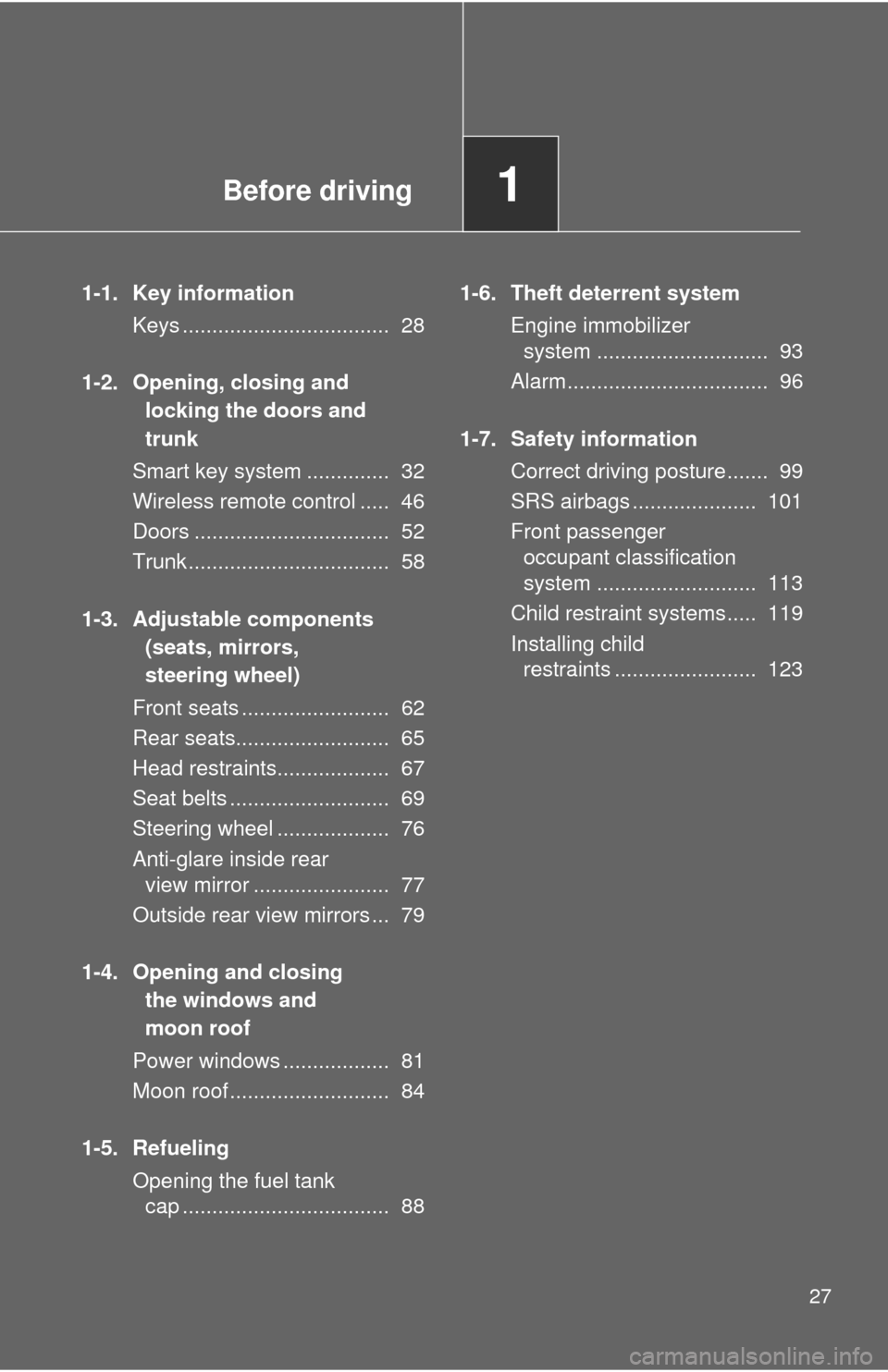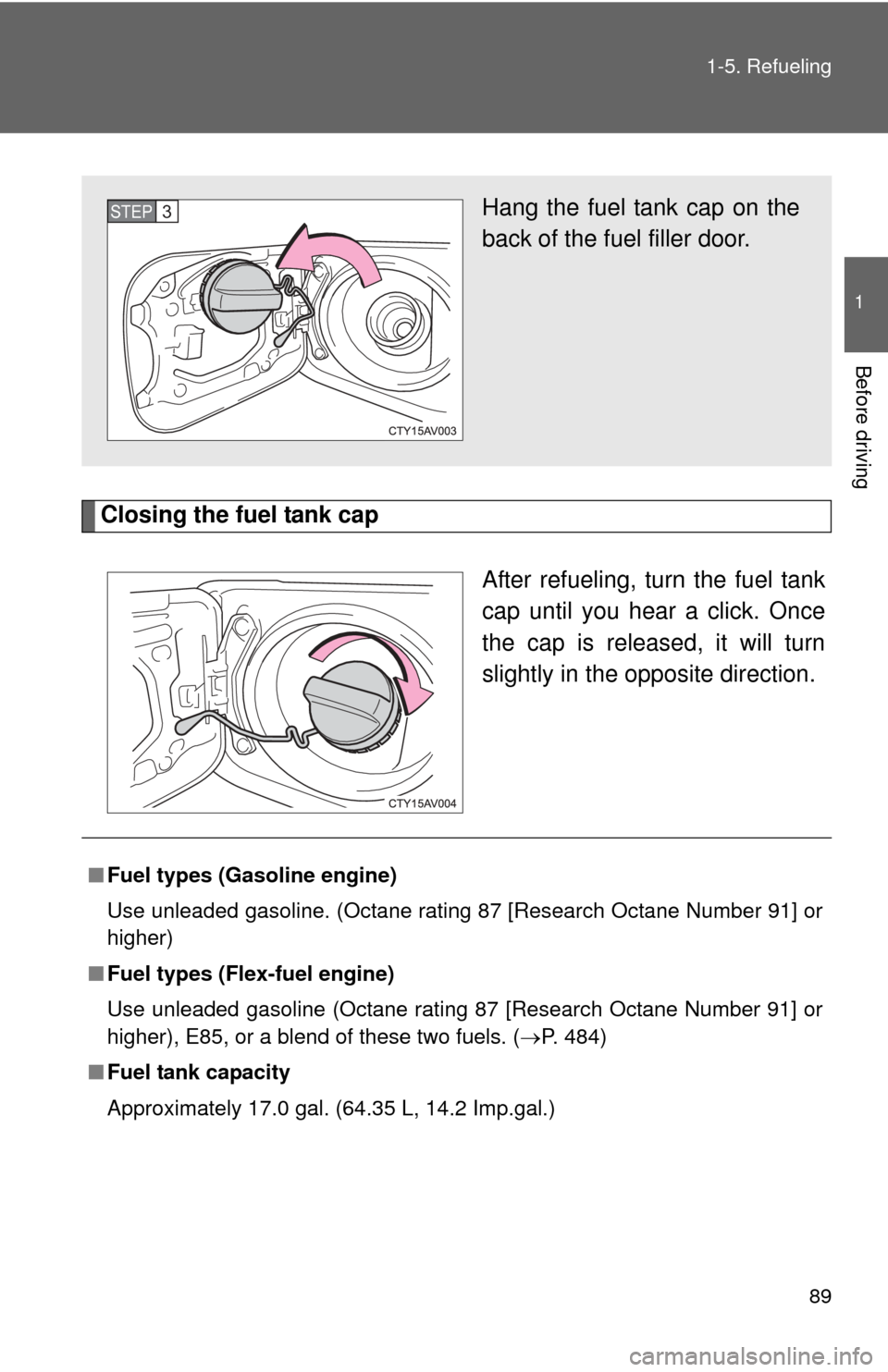fuel TOYOTA CAMRY 2013 XV50 / 9.G Owners Manual
[x] Cancel search | Manufacturer: TOYOTA, Model Year: 2013, Model line: CAMRY, Model: TOYOTA CAMRY 2013 XV50 / 9.GPages: 540, PDF Size: 7 MB
Page 2 of 540

TABLE OF CONTENTSIndex
2
1-1. Key informationKeys ..................................... 28
1-2. Opening, closing and locking the doors and
trunk
Smart key system................. 32
Wireless remote control ....... 46
Doors.................................... 52
Trunk .................................... 58
1-3. Adjustable components (seats, mirrors,
steering wheel)
Front seats ........................... 62
Rear seats ............................ 65
Head restraints ..................... 67
Seat belts ............................. 69
Steering wheel ..................... 76
Anti-glare inside rear view mirror.......................... 77
Outside rear view mirrors ..... 79
1-4. Opening and closing the windows and moon roof
Power windows .................... 81
Moon roof ............................. 84
1-5. Refueling Opening the fuel tank cap .... 88 1-6. Theft deterrent system
Engine immobilizer system ... 93
Alarm .................................... 96
1-7. Safety information Correct driving posture ......... 99
SRS airbags ....................... 101
Front passenger occupant classification system ......... 113
Child restraint systems ....... 119
Installing child restraints ..... 123
2-1. Driving procedures Driving the vehicle .............. 134
Engine (ignition) switch (vehicles without a
smart key system) ............ 145
Engine (ignition) switch (vehicles with a smart
key system) ...................... 148
Automatic transmission (vehicles without paddle
shift switches) ................... 155
Automatic transmission (vehicles with paddle
shift switches) ................... 159
Turn signal lever ................. 166
Parking brake ..................... 168
Horn .................................... 169
1Before driving
2When driving
Page 5 of 540

1
2
3
4
5
6
7
5
5-1. Essential informationEmergency flashers ............ 420
If your vehicle needs to be towed ........................... 421
If you think something is wrong ................................ 424
Fuel pump shut off system .............................. 425
5-2. Steps to take in an emergency
If a warning light turns on or a warning buzzer
sounds... .......................... 426
If you have a flat tire............ 441
If the engine will not start .... 453
If the shift lever cannot be shifted from P............... 455
If you lose your keys ........... 456
If the electronic key does not operate properly.......... 457
If the battery is discharged ........................ 460
If your vehicle overheats ..... 465
If the vehicle becomes stuck ................................. 468
If your vehicle has to be stopped in
an emergency ................... 469 6-1. Specifications
Maintenance data (fuel, oil level, etc.) ........... 472
Fuel information.................. 484
Tire information .................. 489
6-2. Customization Customizable features........ 501
6-3. Initialization Items to initialize ................. 508
Reporting safety defects for U.S. owners ................ 510
Seat belt instructions for Canadian owners
(in French) ........................ 511
SRS airbag instructions for Canadian owners
(in French) ........................ 513
Abbreviation list ......................... 524
Alphabetical index ..................... 526
What to do if... ........................... 536
5When trouble arises6Vehicle specifications
7For owners
Index
Page 7 of 540

7
Tires
●Rotation
● Replacement
● Inflation pressure
● Information
P. 376
P. 441
P. 481
P. 489
Trunk P. 58
Doors P. 52
Rear turn signal lights P. 166
Rear window defoggerP. 246
Stop/tail lights P. 186
Rear side marker light P. 186
Fuel filler door P. 88
: If equipped
*1: For vehicles with a navigation system, refe r to “Navigation System Owner’s Manual”.
*2: For vehicles with a Display Audio system, re fer to “Display Audio System Owner’s Manual”.
Camera , *1, *2
License plate lights P. 186
Page 13 of 540

13
Gauges and meters P. 170
Tilt and telescopic steering rock release lever
P. 76
Pictorial indexInstrument panel
Audio system
Navigation system
, *3
Display Audio system , *4
P. 248
Windshield wiper and washer switch P. 195
Clock P. 307
Parking brake pedal P. 168Hood lock release
lever
P. 359: If equipped
*3: Refer to “Navigation System Owner’s Manual”.
*4: Refer to “Display Audio System Owner’s Manual”.
Horn
P. 169
Engine (ignition) switch (vehicles
with a smart key system)
P. 148
Headlight switch
Turn signal lever
Fog light switch
P. 186
P. 166
P. 193
Fuel filler door opener
P. 88
Trunk opener P. 58
Floor mat P. 319
Page 19 of 540

19
For your information
Main Owner’s Manual
Please note that this manual covers all models and all equipment, including
options. Therefore, you may find some explanations for equipment not
installed on your vehicle.
All specifications provided in this manual are current at the time of printing.
However, because of the Toyota policy of continual product improvement, we
reserve the right to make changes at any time without notice.
Depending on specifications, the vehicle shown in the illustrations may differ
from your vehicle in terms of equipment.
Noise from under vehicle after turning off the engine
Approximately five hours after the engine is turned off, you may hear sound
coming from under the vehicle for several minutes. This is the sound of a fuel
evaporation leakage check and, it does not indicate a malfunction.
Accessories, spare parts and modification of your Toyota
A wide variety of non-genuine spare parts and accessories for Toyota
vehicles are currently available on the market. You should know that Toyota
does not warrant these products and is not responsible for their
performance, repair, or replacement, or for any damage they may cause to,
or adverse effect they may have on, your Toyota vehicle.
This vehicle should not be modified with non-genuine Toyota products.
Modification with non-genuine Toyota products could affect its performance,
safety or durability, and may even violate governmental regulations. In
addition, damage or performance problems resulting from the modification
may not be covered under warranty.
Page 20 of 540

20
Installation of a mobile two-way radio system
The installation of a mobile two-way radio system in your vehicle could affect
electronic systems such as:
●Multiport fuel injection system /sequential multiport fuel injection system
● Cruise control system
● Anti-lock brake system
● SRS airbag system
● Seat belt pretensioner system
Be sure to check with your Toyota dealer for precautionary measures or spe-
cial instructions regarding installation of a mobile two-way radio system.
Page 27 of 540

Before driving1
27
1-1. Key informationKeys ................................... 28
1-2. Opening, closing and locking the doors and
trunk
Smart key system .............. 32
Wireless remote control ..... 46
Doors ................................. 52
Trunk .................................. 58
1-3. Adjustable components (seats, mirrors,
steering wheel)
Front seats ......................... 62
Rear seats.......................... 65
Head restraints................... 67
Seat belts ........................... 69
Steering wheel ................... 76
Anti-glare inside rear view mirror ....................... 77
Outside rear view mirrors ... 79
1-4. Opening and closing the windows and
moon roof
Power windows .................. 81
Moon roof ........................... 84
1-5. Refueling Opening the fuel tank cap ................................... 88 1-6. Theft deterrent system
Engine immobilizer system ............................. 93
Alarm.................................. 96
1-7. Safety information Correct driving posture....... 99
SRS airbags ..................... 101
Front passenger occupant classification
system ........................... 113
Child restraint systems..... 119
Installing child restraints ........................ 123
Page 88 of 540

88
1-5. Refueling
Opening the fuel tank cap
Perform the following steps to open the fuel tank cap:
■Before refueling the vehicle
Vehicles without a smart key system
Turn the engine switch off and ensure that all the doors and win-
dows are closed.
Vehicles with a smart key system
Turn the “ENGINE START STOP” switch off and ensure that all
the doors and windows are closed.
■ Opening the fuel tank cap
Pull up the opener to open the
fuel filler door.
Turn the fuel tank cap slowly
to open.
STEP1
STEP2
Page 89 of 540

89
1-5. Refueling
1
Before driving
Closing the fuel tank cap
After refueling, turn the fuel tank
cap until you hear a click. Once
the cap is released, it will turn
slightly in the opposite direction.
Hang the fuel tank cap on the
back of the fuel filler door.STEP3
■Fuel types (Gasoline engine)
Use unleaded gasoline. (Octane rating 87 [Research Octane Number 91] or
higher)
■ Fuel types (Flex-fuel engine)
Use unleaded gasoline (Octane rating 87 [Research Octane Number 91] or
higher), E85, or a blend of these two fuels. ( P. 484)
■ Fuel tank capacity
Approximately 17.0 gal. (64.35 L, 14.2 Imp.gal.)
Page 90 of 540

90 1-5. Refueling
■Identifying flex-fuel vehicles
■ E85 Fueling Stations (Flex-fuel vehicles)
E85 fueling stations and fuel pumps can be identified by the indication “E85
85% Ethanol”. For more information about fueling stations, please refer to
the U.S. Department of Energy Web site.
http://www.afdc.energy.gov/afdc/locator/stations/
■ Refueling (Flex-fuel vehicles)
Do not alternate between unleaded gasoline and E85 if possible. The driving
performance may not be ensured while the computer is reading the ethanol
concentration.
Observe the following precautions when switching fuels, in order to maintain
starting and driving performance.
●Do not change fuels when the fuel level is 1/4 or less.
● Always add at least 5.0 gal. (18.9 L) of fuel.
● After refueling, drive at a normal speed to warm up the engine until the
engine coolant temperature gauge reaches more than half.
● Do not depress the accelerator pedal rapidly immediately after refueling.
To ensure the driving performance, use the regular unleaded gasoline if pos-
sible when driving short distances often.
■ E85 fuel (Flex-fuel vehicles)
P. 485
Flex-fuel vehicles can be identified by the
fuel tank cap, which is marked “FLEX-
FUEL E85/GASOLINE”.